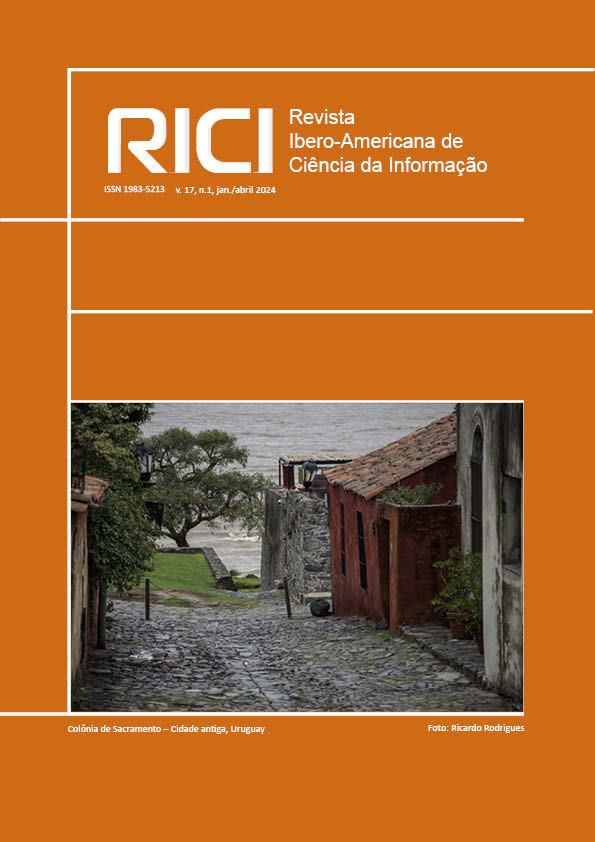The use of blockchain technology and the concept of peer-to-peer networks in the decentralization of art archives:
an introduction to the challenge
DOI:
https://doi.org/10.26512/rici.v17.n1.2024.50858Keywords:
Archives, Collections, Blockchain, Descentralization, InformatonAbstract
This paper is the result of doctoral research that seeks to understand the methods, processes, regimes, and uses of information in the implementation, organization, and recovery of artistic works and digital heritage through the use of machine-learning agents and new technologies like Blockchain, all while building on transdisciplinary scientific theoretical frameworks in the field of information science at the interface with digital humanities. Provides an updated review of these technologies and raises concerns about the post-digital society's tendency to centralize access control and collection systems. The study came to a conclusion by outlining potential applications of these technologies for the long-term decentralization of these systems.
Downloads
References
Abutaha, Mohammed; Farajalha, Mousa; Tahboub, Radwan; Odeh, Mohammed. Survey paper: cryptography is the science of information security. Journal of Computer Science and Information Security, v. 5, n. 3, p. 298-309, 2011.
BENET, Juan. Ipfs-content addressed, versioned, p2p file system. arXiv preprint arXiv:1407.3561, 2014.
Capurro, Rafael; HJørland, Birger. The concept of information. Perspectivas em ciência da informação, v. 12, n. 1, p. 148-207, 2007
CASTELLS, Manuel. A sociedade em rede. São Paulo: Paz e terra, 2005.
COMITÊ GESTOR DA INTERNET NO BRASIL – CGI.br. TIC Cultura 2018: Pesquisa sobre o uso das tecnologias de informação e comunicação nos equipamentos culturais brasileiros: TIC Cultura 2016. São Paulo: CGI.br, 2017b. Disponível em: http://cetic.br/publicacao/pesquisa-sobre-o-uso-das-tecnologias-da-informacao-e-comunicacao-nos-equipamentos-culturais-brasileiros
Coones, Wendy; Rühse, Viola, Grau, Oloiver (Ed.). Museum and archive on the move: changing cultural institutions in the digital era. Berlin, Boston: Walter de Gruyter, 2017.
De Gómez, Maria Nélida González. Regime de informação: construção de um conceito. Informação & Sociedade, v. 22, n. 3, 2012.
IBRAM. Instituto Brasileiro de Museus. Acervos digitais nos museus: manual para realização de projetos. Universidade Federal de Goiás - Brasília, DF: Ibram, 2020. Disponível em: https://www.museus.gov.br/wp-content/uploads/2021/05/Acervos-Digitais-nos-Museus.pdf
International Colloquium. In: Culture for future Manifesto. 2019, Brussels, Belgium. Manifesto. Brussels: European Commission, 2019. Disponível em: https://www.acp-ue-culture.eu/en/blog/the-manifesto-culture-for-the-future-is-out/
Kini, Ranjan B. Peer-to-peer technology: a technology reborn. Information Systems Management, v. 19, n. 3, 2006.
Kostakis, Vasilis; Bauwens, Michel. Network society and future scenarios for a collaborative economy. New York: Springer, 2014.
Lee, Tim, B. Why Tim Berners-Lee Wants to rethink the internet. [Entrevista concedida à CNBC] Emma Barnets Meets. Bloomberg Talks, Youtube. 12 mai. 2022. Disponível em: https://www.youtube.com/watch?v=_0GWG0yCu-w
Leibowitz, B. Manor, H. Peer-to-peer technology as an enabling platform for social computing: an exploratory study. International Journal of Human-Computer Studies, n. 61, p. 757-772, 2004.
Magalhães, Ana Gonçalves; Beiguelman, Giselle. Futuros Possíveis: arte, museus e arquivos digitais. São Paulo: Editora USP, Editora Peirópolis, 2014. P .61-68
Manovich, Lev. Software takes command. Extending the Language of New Media. New York: Bloomsbury Academic, 2013.
Matthews, Brian. Semantic web technologies. E-learning, v. 6, n. 6, p. 8, 2005.
Mayer, Jane. How Russia helped Swing the election or trump. The New Yorker, NY, 24 de Set. 2018. Disponível em: https://www.newyorker.com/magazine/2018/10/01/how-russia-helped-to-swing-the-election-for-trump
McConnell, Steve. Code complete. São Paulo: Pearson Education, 2004.
Mucelli, Tadeus. A visualização e a materialização das artes digitais: um estudo da produção artística. 2017, 140 f. Dissertação (Mestrado em artes) – Escola Guignard, Escola de Música, Universidade do Estado de Minas Gerais, Belo Horizonte, 2017.
Ordonez, E.; Pereira, F.; Chiaramonte, R. Criptografia em Software e Hardware. São Paulo: Novatec, 2005.
Panda, Sandeep Kumar; Jena, Ajay Kuma; Swain, Santosh Kumar; Satapathy; Suresh Chandra (ed.) (ed.). Blockchain technology: applications and challenges. New York: Springer, 2021.
Polkadot. Polkadot, 2023. Disponível em: https://www.polkadot.network/
Saroiu, Stefan; Gummadi, P. Krishna; Gribble, Steven D. Measurement study of peer-to-peer file sharing systems. In: Multimedia computing and networking 2002. Proceedings of SPIE. The International Society for Optical Engineering, 2001. p. 156-170.
Sharma, Pratima; JindaL, Rajni; Borah, Malaya Dutta. A review of smart contract-based platforms, applications, and challenges. Cluster Computing, v. 26, n. 1, p. 395-421, 2023.
TBD Developers. 2023. What is Web5?. Disponível em: https://developer.tbd.website/blog/what-is-web5
Turkle, Sherry. Life on the Screen: identity in the age of the internet . New York: Simon and Schuster. New York, 2011.
Downloads
Published
How to Cite
Issue
Section
License
Copyright (c) 2023 Tadeus Mucelli, Maria Aparecida Moura

This work is licensed under a Creative Commons Attribution 4.0 International License.
Copyright Notice
Authors who publish in this journal agree to the following terms:
- Authors retain copyright and grant the journal right of first publication with the work simultaneously licensed under the Creative Commons Attribution License 4.0, allowing the sharing of work and recognition of the work of authorship and initial publication in this journal.
- Authors are able to take on additional contracts separately, non-exclusive distribution of the version of the paper published in this journal (ex.: distribute to an institutional repository or publish as a book), with an acknowledgment of its initial publication in this journal.
- Authors are permitted and encouraged to distribute their work online (eg.: in institutional repositories or on their website) at any point before or during the editorial process, as it can lead to productive exchanges, as well as increase the impact and citation the published work.
















